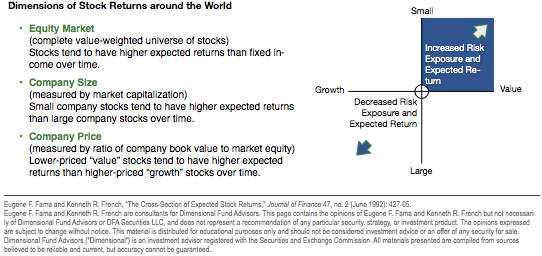Although Wall Street and the media encourage us to believe that we can find a ‘free lunch,’ these opportunities are very difficult to exploit. In other word, there are no low-risk/high expected return investments. Here’s why: if an investment offered a disproportionately higher return for the risk involved, word would spread and others would try to capitalize on it. This additional demand would result in the price of the investment being driven up to the point where it’s expected return is commensurate with other investments of similar risk.
This is the way free markets work: each day the prices of tens of thousands of publicly traded stocks and bonds around the world are continuously repriced to reflect new information—finding equilibrium between risk and return.
Capital market research by academics over the last 50 years has brought us a powerful understanding of the dimensions that drive investment performance. The difference in returns among portfolios is largely determined by relative exposure to; 1) the stock market, 2) small cap stocks, and 3) value stocks. Stocks offer higher expected returns than fixed income due to the higher perceived risk of being in the stock market. Many economists further believe that small cap and value stocks outperform large cap and growth because the market rationally discounts their prices to reflect underlying risk. The lower prices give investors greater upside as compensation for bearing this risk.
Investors who want to earn above-market returns must take higher risks in their portfolio. The crosshair map illustrates that tilting a portfolio toward small cap and value stocks increases the exposure to risk and expected return. Decreasing this exposure relative to the total stock market results in lower risk and lower expected return.
In creating and managing portfolios, we believe the risk/return dimensions of the stock market, small stocks, and value stocks are risks worth taking.

